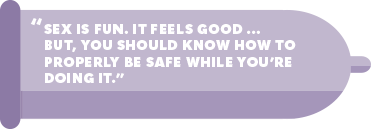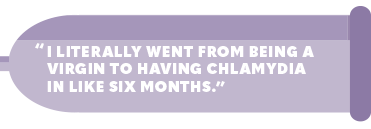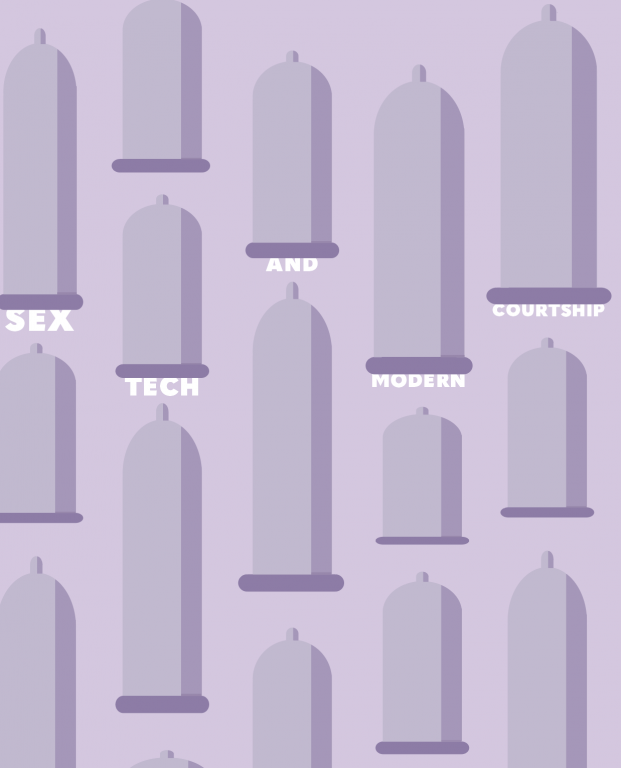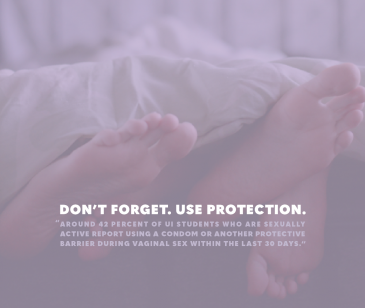Emily Allis wasn’t looking for a relationship when she downloaded Tinder in 2016.
Rather, the University of Idaho fourth-year student wanted to use the location-based mobile app to make platonic connections.
Created in 2012, Tinder allows nearby users to chat with one another after they each swipe right on the other’s photo, creating a match. If users don’t feel they match with the person featured, they can instead swipe to the left.
“I wasn’t against finding someone to date, it just never happened that way,” Allis said. “It was like a networking tool — think LinkedIn for friends.”
But this outlook changed once the 20-year-old from Coeur d’Alene, Idaho, came across her now boyfriend’s profile.
Allis said the two clicked instantly, bonding over a love of travel and music. They met in person after a few weeks of constant communication.
Initially, they thought their relationship wouldn’t last. But the pair soon realized just how much they meant to one another, Allis said.
“We both weren’t looking for a significant other at the time,” she said. “However, it was clear what we were doing wasn’t casual. It was a lot more — it was love.”
Meeting through Tinder allowed the couple of one and a half years to get to know one another on their terms without outside influence, Allis said. Without it, they might never have met.
“Nothing to lose”
However, not all online relationships form so easily.
Growing up in the almost 5,000-person town of Fruitland, Idaho, Ramiro Vargas did not know a single openly gay student at his high school.
Vargas said he spent a majority of his young life questioning his sexuality and eventually turned to the Church of Jesus Christ of Latter-day Saints to help make sense of it.
However, the 20-year-old UI third-year student said he soon realized the Book of Mormon was not the cure.
As he began to understand his identity, Vargas went online in search of a community who he could relate to — one that would accept him as is.
“I knew I was gay, but I’m in this environment where I’m not out … and I’m a part of the Mormon Church,” Vargas said. “There was literally no one else in Fruitland. I really had to turn to social media to find anyone like myself.”
When he came to college, Vargas decided to up the ante and join Tinder, believing the app was his best shot at meeting “others like him” in Moscow.

A couple leans in for a kiss.
He said he was already used to meeting people online and had “nothing to lose” by creating an account, expecting a bigger selection than he found in his hometown and the surrounding areas.
However, Vargas said he quickly realized how naive his initial belief was.
“As much as I thought that the selection was a lot bigger, it really wasn’t,” he said. “Dating is different, but it’s still just as difficult.”
Joining Tinder helped Vargas understand what he was looking for relationship-wise in a medium he was comfortable with, he said.
“I’m not really used to meeting people in person. … I’m comfortable meeting people online with the intention of one-day meeting face-to-face,” Vargas said. “I think of myself as very charismatic over the interwebs.”
Vargas said he didn’t mind if he met someone romantically or platonically — he just wanted to connect with others.
After a few weeks of swiping through Tinder, Vargas went on his first “date.” However, he said he wouldn’t actually call it that.
Vargas received a message from a Washington State student, who said he was on his way to Moscow to pick him up for coffee. The two began talking on the app a few days prior. It was 10 p.m.
“I felt kind of pushed in that situation,” he said. “It was very new, and I had never really used Tinder before. I didn’t know what to expect or what he expected.”
Nerves consumed Vargas once his Tinder match arrived.
He said the situation immediately felt odd — a feeling that only increased as the night progressed.
Vargas attempted to exchange pleasantries, hoping to ease the tension.
“Just by looking at you, I already know how I’m going to kill you,” his date said.
Vargas laughed off the comment, but the apprehension never waned.
From campus, they drove to get coffee, he said. The student paid and Vargas promptly thanked him.
“Now, you owe me,” Vargas’ date said him. What Vargas owed him, he did not know.
After stopping for coffee, they went for a drive across the dark rolling hills, Vargas said. Vargas, then a first-year, didn’t know Moscow well enough at the time, so he was unsure of where he was being taken.
“It was a very flight or fight moment,” he said. “It was incredibly scary not to be in control.”
Eventually, the student dropped him off at home. Relief washed over him as he exited the vehicle.
“There’s so many things that could’ve happened,” he said. “I think a lot of people get in these situations … You never really hear of the dangers with dating apps.”
The pair unmatched two days later. They haven’t talked since.
“I came into this clean”
Like Allis and Vargas, Mia* downloaded Tinder early in her college career. But the 21-year-old wasn’t active on the mobile app until this summer — she never had a desire to be.
However, near the end of her junior year, a break-up with a man she was dating on-and-off for six months changed her outlook, she said.
“I was kind of in a funk, and I wanted to see what else was out there. … I felt like I just wanted to meet someone easier,” the Boise native said. “Honestly, it was a bit of a self-esteem boost.”
Following the split, she reactivated her Tinder account and created a profile on Bumble — a similar app. Created in 2014, Bumble allows only women to send the first message; whereas anyone can start a conversation on Tinder.
In June, Mia went on her first date with someone she met through Bumble while at home for the summer.
The two made plans to meet around 10 p.m. to stargaze. However, it quickly turned into more, she said. He was the third person she ever had sex with. A condom wasn’t used.
“It was the stupidest decision when I think about it now,” she said. “I drove to a stranger’s house in the middle of nowhere. What was I thinking?”
Days later, conversation between the two stalled, she said.
Mia moved on, she said, determined not to dwell on the situation. She soon met another man through the app, and reconnected with a friend from high school.
She had sex with both people within a day of each other. Protection was used with one partner, but not the other.
Soon, Mia said she began to present symptoms she thought mirrored a urinary tract infection and scheduled a medical appointment.
She tested positive for chlamydia — a diagnosis that immediately elicited tears.
After notifying each partner, Mia said she was made to feel as though it was solely her fault in infecting them.
“I came into this clean — someone was lying to me,” Mia said. “There’s a shame that comes with it, but it’s a two-way street.”
Before having intercourse with any of her sexual partners, Mia said she explicitly asked whether they had been recently tested. They all left her with the impression she had nothing to worry about.
Prior to college, Mia never had sex. She still had yet to be kissed.
“I literally went from being a virgin to having chlamydia in like six months,” she said. “I think I’ve been too blindly trusting of people. … I don’t know why it feels so embarrassing, it’s a disease like anything else.”
Graduating from a Catholic high school in Boise, Mia said she lacked a basic understanding of sexual health.
She said her teachers made it seem as though having sex out of wedlock meant a person was automatically going to contract an STI. It was in students’ best interest to wait until marriage, where they would be safe from infection. Contraception was never mentioned.
“All they promoted is abstinence, and you just know that’s not what these kids are doing. … It’s irresponsible to think that people aren’t going to be doing things and they should be well informed before they do,” Mia said. “I wish I had gotten a better sex education when I was younger.”
Fortunately, her mother, who is a family practice doctor, helped fill in some of the gaps. Yet, Mia said she still didn’t feel as prepared as she should have been when coming to college.
“I didn’t really even think about (using a condom) before, which is so stupid,” she said. “I know I know better, or at least I thought I did … I guess I never thought I’d be the type to start hooking up — clearly I am, though.”
Only 52 percent of college students report using a condom during vaginal sex, according to the Centers for Disease Control. That same percentage of students — ages 18 to 24 — also represent almost half of all new sexually transmitted infections (STIs) each year in the United States.
“A very human thing”
Erin Chapman, a UI professor in the family and consumer sciences department, said many college students, such as Mia, often lack basic sexual health teachings, centering their limited knowledge on word-of-mouth encounters with peers and family members.
As a result, Chapman said young people find it harder to discuss sex, making it easier for them to contract various STIs because they aren’t able to effectively communicate needs and expectations. She said students often forget these infections can be transferred during oral sex.
Although many STIs can be cured with antibiotics — chlamydia, gonorrhea and syphilis — some cannot, such as herpes and human immunodeficiency virus (HIV).
A lack of dialogue also contributes to several misconceptions surrounding sex and relationships, such as how frequently college students are engaging in various forms of intercourse, Chapman said.
Students generally believe their peers are more sexually active than they actually are, she said, which can lead them to engage in activities they aren’t quite ready for — feeding into the idea of a “hookup culture” on campus.
Chapman said hookups are difficult to define because there are so many different definitions of what constitutes a hook up. It might be kissing. It might be sex.
“Whether you want to call it ‘hooking up’ or ‘finding a relationship,’ people are always going to find a way to get together,” Chapman said. “The terminology changes, but sex is a very human thing and we don’t do a good enough job talking about it.”
To clear up any confusion, Chapman said she partners with Vandal Health Education and other on-campus offices, such as the Women’s Center and LGBTQA Office, for programming events centered on sex and intimate relationships.
Lysa Salsbury, director of the UI Women’s Center, said the university revamped its efforts after Trojan Condoms released a report in 2010 ranking several U.S. colleges based on their sexual health resources. At that time, UI ranked last out of 140 universities.
Since then, Salsbury said UI climbed the ranks as sexual education has become more centralized, coming in at No. 22 in 2016 — a 32-point difference from the year prior.
“Sex is fun. It feels good,” Salsbury said. “But, you should know how to properly be safe while you’re doing it.”
Madeline Brown, a graduate support assistant with Vandal Health, said the organization was created specifically to address the importance of engaging in safe sexual activities, as well as many other student health concerns, such as binge drinking and drug use.
Brown said abstinence-only curriculums — like the one Mia encountered — provide limited information and can often make sex seem like a taboo topic, but students have a “human right to learn.”
The state of Idaho hasn’t updated it’s sexual education policy since 1970.
“(Students) come here to learn things that will affect the rest of their lives … and sex health is a huge part of life — it’s a human need,” Brown said. “So, it’s important that we educate our students about safe sex and what healthy sex looks like.”
Around 42 percent of UI students who are sexually active report using a condom or another protective barrier during vaginal sex within the last 30 days, according to a 2017 study conducted by the American College Health Association.
Brown said Vandal Health primarily focuses on promoting condom use — internal or external — and informing students about STIs.
Free condoms and other contraceptives, such as dental dams, are available throughout campus and in several residence halls, she said. STI testing is available for students at the Student Health Clinic downtown, as well.
“You like what you like,” Brown said. “Have sex if you want to, but don’t if you don’t. … (Either way) use a condom whenever you decide to have sex — protect yourself from STIs.”
“Protect yourself”![]()
After being diagnosed with chlamydia, Mia said she much more cautious when it comes to using protection during sex and plans to make getting tested a part of her regular health routine. She still doesn’t know who infected her.
Rather than feeling ashamed about having an STI, Mia said people should learn from it and “brush up on their sexual health.”
“(STIs) are more common than you think, and you shouldn’t feel ostracized because people get them a lot, they just don’t talk about it,” Mia said. “It’s important to get tested, especially if you’re seeing a lot of people.”
She remains active on Tinder and Bumble.
Like Mia, Vargas said he wasn’t going to be deterred by one negative experience.
He continues to use Tinder, as does Allis despite being in a relationship. She said the app has been a great tool for meeting friends, especially while traveling.
“Sex is about both people having fun, and worrying whether or not this person is going to give you an STI is the opposite of that. There are one’s that stay with you forever,” Mia said. “It doesn’t matter where you meet — Tinder, Bumble, the library or whatever — just be safe.”
*At her request, Mia’s name has been changed to protect her identity.

